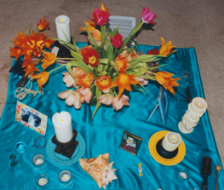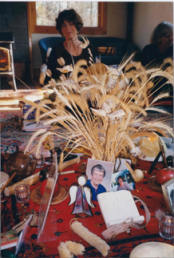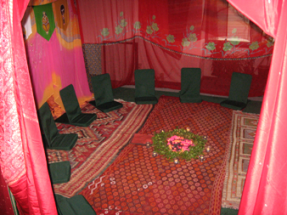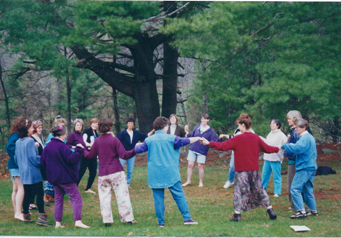Altars and Ritual
From the very first session of the very first program, there was always an altar at the center of the circle. Several of us sensed that altars were one of the things that were being "given back to women" during the seventies, eighties, and nineties when women's spirituality was having a resurgence. By "given back," what we meant was that the making of altars and the creating of sacred space was ancient knowledge that had been lost to most women in this patriarchal era, where materialism and the rule of the fathers were dominant.
Anne Yeomans experienced this very personally in her work as a facilitator. She was teaching with a friend in England in the late 1980s. The two of them had been leading groups for the previous ten years that were more akin to therapy groups than what later came to be known as circle work. However, on this occasion, they decided to put flowers and some scarves and jewelry from their suitcases in the center of the teaching room. Though they didn't realize it at first, they had begun to transform the group into a sacred circle - a circle with a spiritual center.
 Anne remembers saying to her co-leader that day, "I think we have created an altar." It was not language she had ever used before in quite this way. Previously, her only association with altars had been seeing them at the front of churches, presided over by male priests or ministers. For a moment, she said she felt like a heretic for simply uttering the words, "I think we have created an altar." It felt as if "God" might punish her for even assuming such a thing.
Anne remembers saying to her co-leader that day, "I think we have created an altar." It was not language she had ever used before in quite this way. Previously, her only association with altars had been seeing them at the front of churches, presided over by male priests or ministers. For a moment, she said she felt like a heretic for simply uttering the words, "I think we have created an altar." It felt as if "God" might punish her for even assuming such a thing.
However, as she reflected more on it all, she began to realize that she had actually been creating sacred places and sacred corners in every home she had ever lived in, although she had never thought of it that way before. It was a wonderful realization and, as it became conscious, her trust in the transformative power and beauty of altars completely replaced her earlier fears.
Altars at the Women's Well
At the Women's Well there was always an altar at the center of the circle. It became a place of great creativity, and meaning. Some women were uncomfortable with the use of the word altar, just as Anne had been in the beginning. The Deep River groups, created by Abby Seixas, came up with the word "hearth" as an alternative. By whatever name it was called, a beautiful and conscious creation at the center became essential to informing the sacred space of the circle.
At the Well we tried to have the altar set up ahead of time, so that when the women arrived, it would be there, complete with lighted candles, already changing the energy in the room and welcoming all who entered. And at the end of the evening we always left some simple elements of the circle and its altar out - maybe just a few chairs, or back-jacks, around an altar cloth or a plant in the center. We called it "leaving the bones of the circle there." To us, this symbolized that the spirit of the circle was always present.
In working with altars, we were tapping into something very deep in all of us. When we talked about it together we realized that many of us already had sacred corners in our homes. We had places where, without thinking much about it or calling it anything special, we had put objects of beauty around, natural objects like stones or feathers, or something else that felt sacred to us. If someone who didn't understand their significance left a coffee cup or a notebook there, it would bother us and we would remove it. We also realized that many of us had been making centerpieces on our dinner tables for years, without considering that this too was altar making.
Some of the women remembered that their mothers did this, too, as they set the table each night. We saw that the impulse to make altars was deep in the unconscious of women, and that in many ways we were reclaiming this ability, as we were reclaiming so much of ourselves that had been lost. As we made these sacred ways conscious, we could use them more intentionally in our own lives. It also meant that we were better able to protect the sacred from ridicule, shame, or trivialization. One woman experimented with putting a single rose in a vase on a hospital conference table for a meeting of medical personnel, staff, and family members of an individual being treated for cancer. She discovered that this simple action completely transformed the mood and tone of the meeting, that it helped each person there slow down and be more present to the other people in the room rather than focusing exclusively on the logistics of care planning for the patient.

Altar making and the transforming of physical space into sacred space was one of the many strengths of women that had been buried in the male-dominated, secular, and materialistic society that we had all grown up in. In such a culture these gifts had been so undervalued or made invisible that we had lost sight of them ourselves. With the support of each other we were changing that. At the Women's Well, courses were taught in creating altars and rituals, and participants were encouraged to give expression to whatever they experienced as beautiful and sacred.
Creating Ritual
Ritual was a part of the work of reclaiming that went on in the circle. Twentieth-century America was, as someone once said, "ritual poor." For many of us, exploring the power of ritual was very new, and unfamiliar.
The ritual of the circle itself
There was the basic ritual of sitting in circle. When we entered the room, often the altar was set up already with candles lit. We put our bags and coats to the side, and at first sat without speaking, just taking in the altar and the feeling in the room. Margo Adler, one of the teachers in the Women's Spirituality Program said, "An altar is something that, when you behold it, it brings you back to yourself." And so it often did, and in the presence of the altar, and in the quiet of the room, we were able to leave behind the stresses of the day and just settle in.
 Then would come the time of "opening the circle." Whoever was facilitating or "holding" would open the circle in some kind of ritual way. Some people opened with a song, or a bell or chime, or a period of silence. Others opened with the frame drum, and prayers to the four directions. Often there would be a brief guided meditation to support women in letting go of tensions and becoming present to themselves, and to the circle. After that there would be what we called a check-in, a time when we would pass a "talking object" around the circle and each woman in turn could speak briefly about herself and her experience, particularly about what was currently moving strongly in her life.
Then would come the time of "opening the circle." Whoever was facilitating or "holding" would open the circle in some kind of ritual way. Some people opened with a song, or a bell or chime, or a period of silence. Others opened with the frame drum, and prayers to the four directions. Often there would be a brief guided meditation to support women in letting go of tensions and becoming present to themselves, and to the circle. After that there would be what we called a check-in, a time when we would pass a "talking object" around the circle and each woman in turn could speak briefly about herself and her experience, particularly about what was currently moving strongly in her life.
The use of a talking object was a practice that came from indigenous cultures. It was traditionally called a "talking stick" and was usually a beautiful piece of wood, often carved and decorated with beads, feathers, or other small objects from nature. In our women's circles we sometimes used a talking bowl or other sacred object from the altar. The talking object was passed from person to person. Whoever held it had an opportunity to speak or be silent. People were encouraged not to plan their speaking ahead of time, but to be present to themselves in the moment, and let the words come from there. It was always an option to hold the talking object in silence and not to speak in words. There was no rush and no cross-talk or commenting on what was said.
After the check-in there might be some kind of teaching, or a question offered for participants to reflect on, or a creative activity related to a theme we were exploring.
The circle would also close in some kind of ritual way. We didn't just casually drift away from each other, but took time to really mark the ending, by something as simple as holding hands, or blowing out the candles. Singing, chanting, the ringing of a bell, or taking a moment of silence together might also be used.
Planned ritual
 Sometimes we would plan a specific ritual to mark a significant moment on the Wheel of the Year, like a Winter Solstice ritual in the Red Tent, or an Equinox ritual in the spring or fall. Sometimes a planned ritual was used when we knew that there was a particular need for healing.
Sometimes we would plan a specific ritual to mark a significant moment on the Wheel of the Year, like a Winter Solstice ritual in the Red Tent, or an Equinox ritual in the spring or fall. Sometimes a planned ritual was used when we knew that there was a particular need for healing.
All of us who were there will remember vividly the night we first showed Donna Read's film, The Burning Times, about the period of the witch burnings in Europe when many, many woman who were healers and midwives were put to death. The film was so powerful that it was hard for anyone to speak after it. Two women in the group created a ritual for us. There were many unlit candles on the altar, all shapes and sizes. We sat in silence for a time, and then we were invited to come forward and light a candle and/or offer a prayer. It was a way we could hold the power of what we had witnessed and the depth of our feelings of loss and rage. We will never forget it.
Anne Yeomans recently (2016) had the opportunity to meet Donna Read at a women's conference, and thank her for her films (The Goddess Remembered, The Burning Times, and Full Circle). Anne told her of the candle ritual we had developed after the Burning Times film. Donna was very moved and agreed that, of course, ritual was absolutely what was called for. She said, "You can't just have a discussion after seeing this film - it is totally inadequate."
The spontaneous ritual
We learned that even though one might have planned the elements of a ritual carefully, there would often be surprises. The best rituals are alive and have a life of their own; they are not something to be tightly controlled or totally orchestrated. New and spontaneous elements will emerge. Over time, we learned to trust those moments more and more, and welcome them when they came. This was a new learning for many of us, especially for the highly organized planners among us.

The content on this web site is a co-creation of a number of women, to whom we are extremely grateful. The image on our banner (top of page) depicts the interior of a Karanovo dish from Bulgaria, c. 4500 BC. Source: Figure 338, page 218, The Language of the Goddess, by Marija Gimbutas. Joan Marler, ed. New York: Harper & Row, 1989; used with permission.
If you wish to contact us, we have a gmail address. Our screen name is womenswellinfo.
Web hosting is provided by freehostia.com.
If you wish to contact us, we have a gmail address. Our screen name is womenswellinfo.
Web hosting is provided by freehostia.com.
